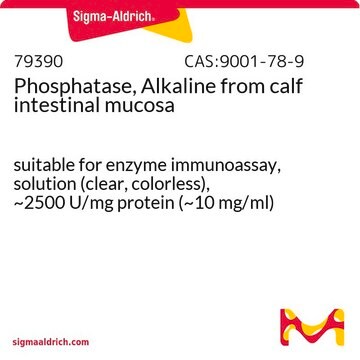APMB-RO
Roche
Alkaline Phosphatase
solution, from bovine (calf) intestine, 2 units/μg protein, optimum pH 7.5-9.5
Synonim(y):
ALP, CAP, CIAP, calf intestinal phosphatase, cip, orthophosphoric monoester phosphohydrolase
About This Item
Polecane produkty
pochodzenie biologiczne
bovine (calf) intestine
Poziom jakości
Postać
solution
aktywność właściwa
2 units/μg protein
opakowanie
pkg of 1,000 U (10713023001 [1 U/μl])
pkg of 1,000 U (11097075001 [20 U/μl])
producent / nazwa handlowa
Roche
Parametry
37 °C optimum reaction temp.
optymalne pH
7.5-9.5
Warunki transportu
wet ice
temp. przechowywania
2-8°C
Powiązane kategorie
Opis ogólny
Zastosowanie
Note: The 11097075001 preparation has a high concentration of enzyme (20 U/μl), which is convenient for large-scale experiments. The 10713023001 preparation is a lower concentration (1 U/μl), which is convenient for small-scale experiments.
Sekwencja
Definicja jednostki
Note: According to Moessner et al. 5 units alkaline phosphatase (+37 °C; diethanolamine buffer) correspond to 1 unit alkaline phosphatase (+25 °C; glycine/NaOH buffer).
Unit Conversion: Approx. 3.6 U (MB grade AP)
[+37 °C, 4-NPP as substrate, diethanolamine as buffer, pH 9.8] = 1 U [+25 °C, 4.NPP as substrate, glycine as buffer, pH 10.5].
Volume Activity: 20 U/μl for the 11097075001 preparation. 1 U/μl for the 10713023001 preparation.
Postać fizyczna
11097075001: Enzyme solution (20 U/μl) in storage buffer, pH 7.6 (20 °C)
Uwaga dotycząca przygotowania
Storage conditions (working solution): Dilutions (1 to 5 U/μl) of MB grade AP in the storage buffer are stable for 17 months at 2 to 8 °C.
Higher Dilutions (~0.01 U/μl) should be made fresh daily and kept at 2 to 8 °C.
Preventing self-ligation of vectors during cloning
If a linearized vector lacks a 5′ phosphate, it cannot ligate to itself or form concatamers that contain multiple copies of the vector. Thus, the product of the ligation reaction is predominantly recombinant DNA (vector + DNA insert), rather than religated plasmid.
Inactivation: Add 1/10 volume of EGTA to the reaction mix and incubate at +65°C for 10 minutes. To ensure complete inactivation of enzyme, extract the mix with phenol/chloroform/isoamyl alcohol to remove all protein.
Inne uwagi
Kod klasy składowania
12 - Non Combustible Liquids
Klasa zagrożenia wodnego (WGK)
WGK 1
Temperatura zapłonu (°F)
does not flash
Temperatura zapłonu (°C)
does not flash
Certyfikaty analizy (CoA)
Poszukaj Certyfikaty analizy (CoA), wpisując numer partii/serii produktów. Numery serii i partii można znaleźć na etykiecie produktu po słowach „seria” lub „partia”.
Masz już ten produkt?
Dokumenty związane z niedawno zakupionymi produktami zostały zamieszczone w Bibliotece dokumentów.
Klienci oglądali również te produkty
Nasz zespół naukowców ma doświadczenie we wszystkich obszarach badań, w tym w naukach przyrodniczych, materiałoznawstwie, syntezie chemicznej, chromatografii, analityce i wielu innych dziedzinach.
Skontaktuj się z zespołem ds. pomocy technicznej






